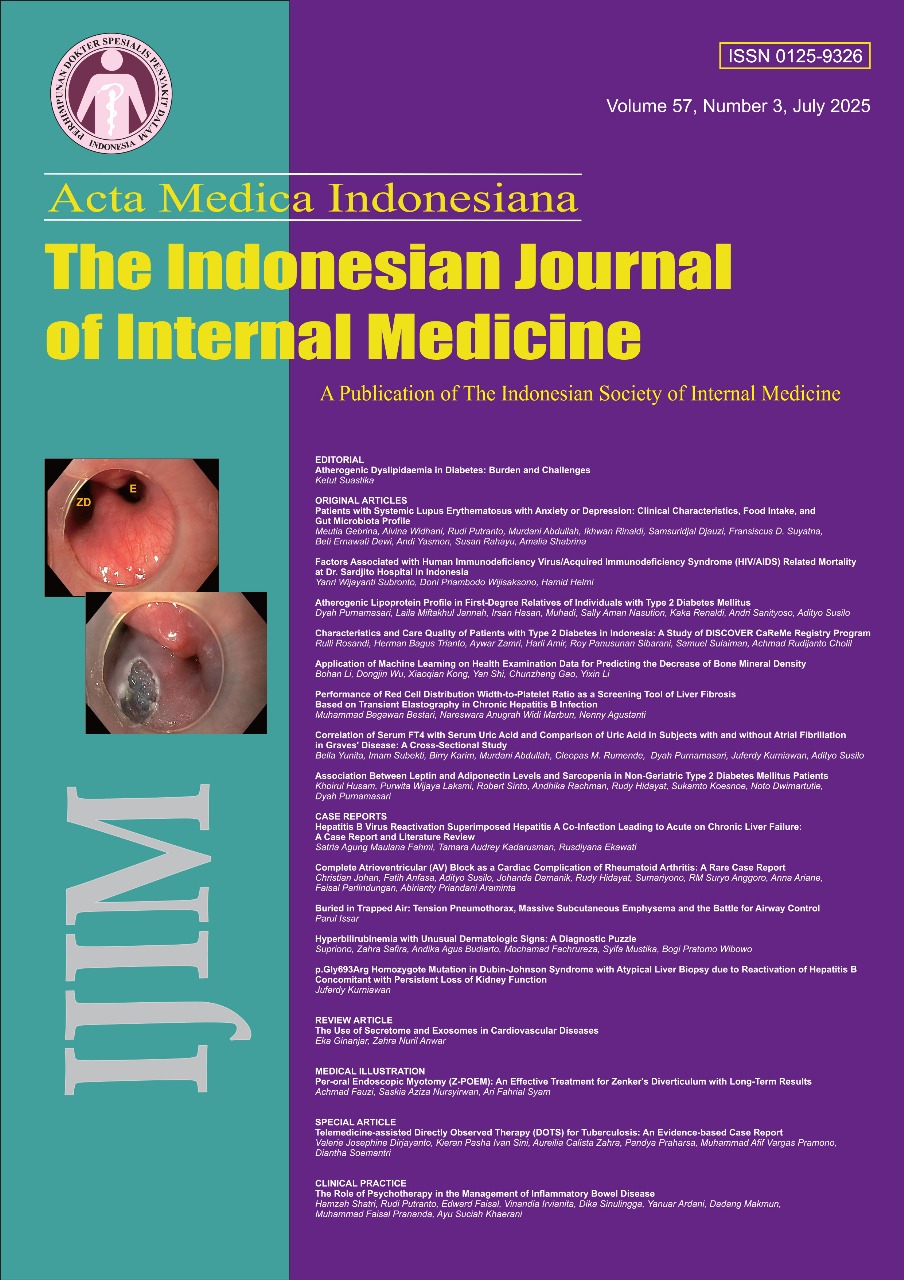Hyperbilirubinemia with Unusual Dermatologic Signs: A Diagnostic Puzzle
Keywords:
cutaneous manifestations, hyperbilirubinemia, Primary Biliary Cholangitis (PBC), transaminitisAbstract
Jaundice, characterized by yellow discoloration of the skin, mucous membranes, and sclera, results from hyperbilirubinemia and is uncommon in adults. Its occurrence often signals serious underlying conditions. Hyperbilirubinemia may also present with cutaneous manifestations, including xerosis, hyperpigmented plaques, and erythematous rashes. A 47-year-old woman presented with hyperbilirubinemia, transaminitis, and cutaneous manifestations, including hyperpigmented plaques on the face, erythematous rashes on the hands and feet, and yellowish discoloration of the skin. Despite extensive evaluation, including viral hepatitis screening, autoimmune markers, and imaging, a definitive diagnosis remained elusive. The clinical features and laboratory findings suggested Primary Biliary Cholangitis (PBC) as the most likely diagnosis, although further confirmation through advanced serological testing and liver biopsy was needed. Treatment with ursodeoxycholic acid (UDCA) and high-dose oral methylprednisolone showed clinical improvement but persisted in transaminitis with a normal ultrasonographic appearance. This case emphasizes the importance of recognizing cutaneous signs in systemic diseases and the need for a comprehensive diagnostic approach in resource-limited settings.References
Fargo MV, Grogan SP, Saguil A. Evaluation of jaundice in adults. Am Fam Physician. 2017;95(3):164-8.
Godara S, Thappa D, Pottakkatt B, et al. Cutaneous manifestations in disorders of the hepatobiliary system. Indian Dermatol Online J. 2017;8(1):9. doi:10.4103/2229-5178.198760
Tanaka A, Ma X, Takahashi A, Vierling JM. Primary biliary cholangitis. Lancet. 2024;404(10457):1053-66. doi:10.1016/S0140-6736(24)01303-5
Younossi ZM, Bernstein D, Shiffman ML, et al. Diagnosis and management of primary billiary cholangitis. American Journal of Gastroenterology. 2019;114(1):48-63. doi:10.1038/s41395-018-0390-3
Hirschfield GM, Dyson JK, Alexander GJM, et al. The British Society of Gastroenterology/UK-PBC primary biliary cholangitis treatment and management guidelines. Gut. 2018;67(9):1568-94. doi:10.1136/gutjnl-2017-315259
Boonstra, Kirsten, Beuers U, Ponsioen CY. Epidemiology of primary sclerosing cholangitis and primary biliary cirrhosis: a systematic review. Journal of Hepatology. 2012;56(5) 1181-1188.
Ma D, Ma J, Zhao C, Tai W. Reasons why women are more likely to develop primary biliary cholangitis. Heliyon. 2024;10(4):e25634. doi:10.1016/j.heliyon.2024.e25634
Brkić M. The role of E2/P ratio in the etiology of fibrocystic breast disease, mastalgia, and mastodynia. Acta Clin Croat. Published online in 2018. doi:10.20471/acc.2018.57.04.18
Purohit T. Primary biliary cirrhosis: Pathophysiology, clinical presentation, and therapy. World J Hepatol. 2015;7(7):926. doi:10.4254/wjh.v7.i7.926
Chalifoux SL, Konyn PG, Choi G, Saab S. Extrahepatic manifestations of primary biliary cholangitis. Gut Liver. 2017;11(6):771-780. doi:10.5009/gnl16365
Terziroli Beretta-Piccoli B, Guillod C, Marsteller I, et al. Primary biliary cholangitis associated with skin disorders: A case report and review of the literature. Arch Immunol Ther Exp (Warsz). 2017;65(4):299-309. doi:10.1007/s00005-016-0448-0
Koulentaki M, Ioannidou D, Stefanidou M, et al. Dermatological manifestations in primary billiary cirrhosis patients: A case-control study. Am J Gastroenterol. 2006;101(3):541-6. doi:10.1111/j.1572-0241.2006.00423.x
Zhang Y, Zheng T, Huang Z, Song B. CT and MR imaging of primary biliary cholangitis: a pictorial review. Insights Imaging. 2023;14(1):180. doi:10.1186/s13244-023-01517-3
Barba Bernal R, Ferrigno B, Morales EM, et al. Management of primary biliary cholangitis: Current treatment and future perspectives. The Turkish Journal of Gastroenterology. 2023;34(2):89-100. doi:10.5152/tjg.2023.22239
van Hooff MC, Werner E, van der Meer AJ. Treatment in primary biliary cholangitis: Beyond ursodeoxycholic acid. Eur J Intern Med. 2024;124:14-21. doi:10.1016/j.ejim.2024.01.030
Marchioni Beery RM VHFF. Primary biliary cirrhosis and primary sclerosing cholangitis: a review featuring a women’s health perspective. J Clin Transl Hepatol. 2014;2(4). doi:10.14218/JCTH.2014.00024
Downloads
Published
How to Cite
Issue
Section
License
Copyright (c) 2025 Supriono Supriono, Zahra Safira, Andika Agus Budiarto, Mochamad Fachrureza, Syifa Mustika, Bogi Pratomo Wibowo

This work is licensed under a Creative Commons Attribution 4.0 International License.
Copyright
The authors who publish in this journal agree to the following requirements:
- Authors retain copyright and grant the journal right of first publication with the work simultaneously licensed under a Creative Commons Attribution 4.0 International License (CC BY 4.0) that allows others to share the work with an acknowledgement of the work's authorship and initial publication in this journal.
- Authors can enter into separate, additional contractual arrangements for the non-exclusive distribution of the journal's published version of the work (e.g., post it to an institutional repository or publish it in a book), with an acknowledgement of its initial publication in this journal.
- Authors are permitted and encouraged to post their work online (e.g., in institutional repositories or on their website) before and during the submission process, as it can lead to productive exchanges, as well as earlier and greater citation of published work. (See The Effect of Open Access)
Privacy Statement
The names and email addresses entered in this journal site will be used exclusively for the stated purposes of this journal and will not be made available for any other purpose or to any other party.




